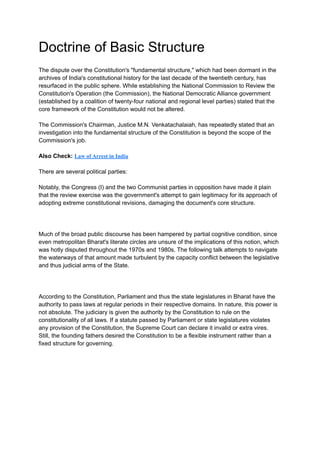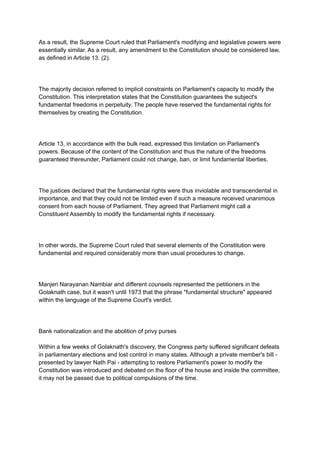The document discusses the resurgence of the debate surrounding the 'fundamental structure' of the Indian Constitution, particularly in light of the National Commission's review and the concerns over extreme constitutional amendments. Key legal cases such as Golaknath and Kesavananda Bharati have shaped the understanding of parliamentary powers versus judicial authority, emphasizing the inviolability of fundamental rights against amendments that could distort the Constitution's essential framework. The ongoing tension reflects the conflict between legislative intentions and judicial interpretations in safeguarding constitutional principles.

![As a result, Parliament was given the authority to modify the Constitution. Article 368 of the
Constitution gives the impression that Parliament's amending powers are unlimited and
cover all aspects of the document. However, since its inception, the Supreme Court has
acted as a check on Parliament's hunger for legislation. To protect the original principles
envisaged by the constitution-makers, the Supreme Court ruled that Parliament could not
distort, harm, or modify the core structure of the Constitution under the guise of altering it.
The phrase "fundamental structure" does not appear in the Constitution. In the landmark
Kesavananda Bharati case in 1973, the Supreme Court recognized this concept for the first
time. Since then, the Supreme Court has served as the interpreter of the Constitution and
hence the adjudicator of all amendments proposed by Parliament.
The Position of Pre-Kesavananda
The ability of Parliament to change the Constitution, particularly the chapter on the basic
rights of voters, was contested as early as 1951. Many laws were enacted inside the states
following independence with the goal of changing land possession and residence patterns.
This was in keeping with the ruling Congress party's electoral promise of implementing the
Constitution's socialistic goals [contained in Article 39 (b) and (c) of the Directive Principles
of State Policy], which required equitable distribution of production resources among all
voters and a prohibition on concentration of wealth in the hands of a few.
Property owners, who were harmed by these laws, petitioned the courts. The courts struck
down the land reform measures, claiming that they violated the fundamental right to property
guaranteed by the Constitution. Piqued by the unfavorable decisions, Parliament included
these laws into the Ninth Schedule of the Constitution by the 1st and 4th amendments (1951
and 1952, respectively), essentially removing them from the purview of review.
[The Ninth Schedule was inserted to the Constitution by the 1st Amendment in 1951 as a
mechanism of shielding bound statutes from scrutiny. According to the provisions of Article
31, which were amended many times later, laws placed within the Ninth Schedule relating to
the acquisition of personal property and compensation due for such acquisition cannot be
challenged in a court of law on the grounds that they violated voters' basic rights.](https://image.slidesharecdn.com/doctrineofbasicstructure-221031055722-78dbc36c/85/Doctrine-of-Basic-Structure-pdf-2-320.jpg)



